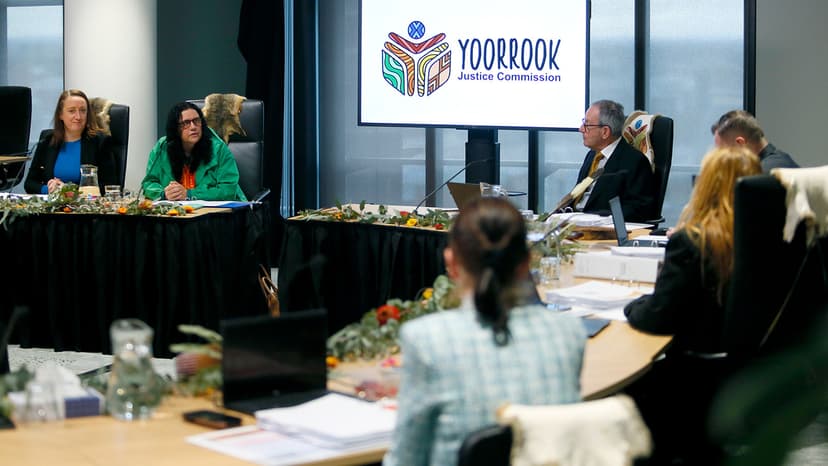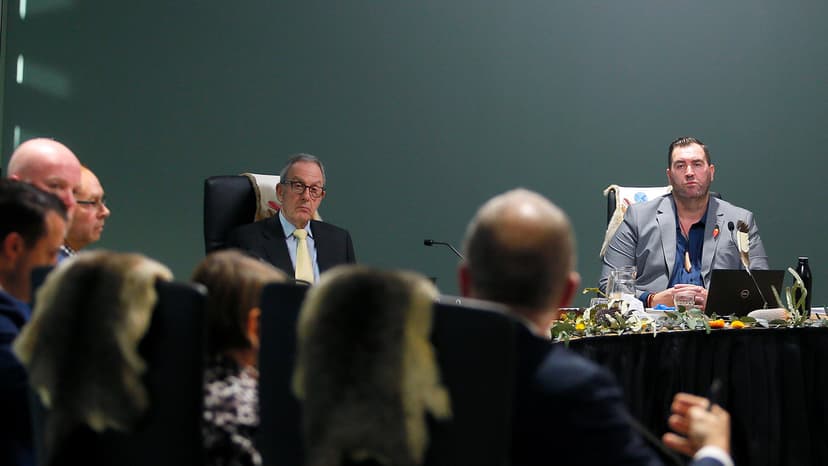Housing
First Peoples in Victoria face systemic housing inequality, with far higher rates of homelessness, rental stress and housing insecurity. Despite policy commitments, government support remains inadequate.
This page has been adapted from the Yoorrook Justice Commission reports, which are fully referenced. For referenced information please view the reports linked on this page.
sensitive material warning
Please be aware that this page may contain sensitive material. Read our self care guidelines to help manage any feelings of distress.
Housing and First Peoples in Victoria
Endemic homelessness, over-representation in social housing, discrimination in the private rental market, and significantly lower rates of home ownership than non-First Nations Victorians characterise the crisis.
The State has recognised the unequal position of First Peoples at all levels of the housing system. Despite policy frameworks and commitments, the Victorian Government has not provided sufficient support or resources to meet the housing needs of First Peoples.
Aboriginal Community Controlled Organisations are delivering good housing outcomes for First Peoples. A lack of adequate resourcing and bureaucratic barriers are the only barriers to expanding their services and client numbers. It is time to progress self-determination in the housing system.
On this page you will find some of the responses Yoorrook has received as part of its inquiry.
Housing Timeline
For over 65,000 years First Peoples lived freely, and home was with kin on Country. There was no homelessness prior to colonial settlement. Victorian First Peoples lived in villages made up of stone dwellings and houses constructed from other materials.
This timeline traces key moments that have shaped housing experiences for First Peoples.
Widespread displacement of First Peoples due to settler encroachment and violence
Through the 1800s First Peoples are rapidly displaced as settlers encroach on their land, often resulting in violence [see Land timeline].
Protectorate Stations established and dismantled
In the 1840s small Protectorate Stations were established by colonial authorities in locations including the Merri Creek Protectorate, Nerre Nerre Warren Station, Mount Rouse, Goulburn Station and Loddon Protectorate. These were considered an expensive failure and the Protectorate was dismantled in 1848.
Aborigines Protection Act passed, enabling forced relocation
The Colonial Government passed the Aborigines Protection Act 1869. The Act and associated regulations gave the Board for the Protection of the Aborigines (BPA) the powers to prescribe where First Peoples could live and the power to control their movements. First Peoples were segregated off their Country and from their homes into missions and reserves, although a number of First Peoples continued to live away from BPA and government control, especially along the Murray River.
‘Half-Caste’ Act forces many off reserves, resulting in homelessness
The Aborigines Protection Act 1886 (Vic) ‘forced Aboriginal people deemed to be “half-caste” off reserves’ which resulted in many First Peoples becoming homeless.
Board for the Protection of Aborigines enacts ‘Concentration Plan’
The BPA realised their long-held ‘Concentration Plan’, the forced removal of all First Peoples to the Lake Tyers reserve as other reserves were closed. Some First Peoples refused to move and remained at Lake Condah, Antwerp, Coranderrk and Framlingham.
Lake Tyers becomes sole remaining managed reserve
By 1925 the BPA reported that Lake Tyers reserve was the only one that continued to operate under the control of a manager. The BPA ‘closed’ Coranderrk (1924) and Lake Condah (1919) but some residents remained, having fought the forced relocation.
Housing Investigation and Slum Abolition Board established
The Victorian Government passed the Slum Reclamation and Housing Act 1938 (Vic)
Growing urban and fringe communities
1940s-1950s: Decades of government policy, including exclusion from reserves and First Peoples’ resistance to the punitive conditions on reserves, resulted in growing numbers of First Peoples living as fringe dwellers, at sites such as river flats. As well, First Peoples moved to Melbourne, to places such as Footscray, North Melbourne and especially Fitzroy where a community developed, resulting in development of First Peoples-led services in the later decades of the twentieth century.
Community-run hostels support First Peoples in urban areas
1950s-onwards: First Peoples community-developed and run Girls and Boys Hostels opened in Melbourne for young First Peoples coming to Melbourne to look for work, get an education or training. They were also places of employment for First Peoples. Initially located in Northcote, hostels were also developed in Thornbury, Dandenong and Fitzroy and rural sites such as Morwell, and included hostels that met various community needs, such as for families, as a men’s night shelter and to support those recently released from imprisonment and the elderly.
Native Welfare Conference adopts assimilation policy, focusing on re-housing
Native Welfare Conference adopted assimilation as the official policy for First Peoples, a key focus of which was re-housing. This was a revitalisation of a 1937 assimilation policy that was placed on hold during World War Two.
Lake Tyers residents successfully petition for permanent reserve status
Lake Tyers residents petitioned against the closure of the reserve and advocated for an independently run cooperative. These protests were successful and in 1965 Lake Tyers became a permanent reserve.
Aborigines Act establishes the Aborigines Welfare Board to implement assimilation policy
The Victorian government passed the Aborigines Act 1957 (Vic) which established the Aborigines Welfare Board (AWB) to oversee the implementation of the assimilation policy.
Rumbalara Housing Settlement opens as first AWB housing project
Rumbalara Housing Settlement opened – the AWB’s first housing project built ten prefabricated houses to house families previously living on the riverside flats at Mooroopna. The houses were let at subsidised rents.
AWB highlights housing crisis and its link to child removals
The AWB requested funding from the Victorian Government to provide houses for First Peoples, noting that Aboriginal housing was some of the ‘worst in the state’ and contributed to First Peoples’ children being taken by police and placed in care. The AWB reported that ‘generally Aboriginal housing throughout the State is undoubtedly of the lowest standard of all poor housing’ and as a consequence children ‘having been placed under the care of hospitals and welfare departments’.
Aborigines (Houses) Act passed to enable public housing for First Peoples
The Victorian government passed the Aborigines (Houses) Act 1959 (Vic) which ‘provided for the Housing Commission to enter into contracts to build houses for Aborigines [sic] on behalf of the Aborigines Welfare Board.’ This responsibility later passed to the Ministry for Aboriginal Affairs.
Second housing project by the AWB in Robinvale, the Manatunga Housing Settlement, with 12 houses.
Fitzroy remains a vital hub for First Peoples community and connection
1960s-1980s: Fitzroy continued its role as a meeting place for First Peoples, where they often found family and community.
Referendum leads to constitutional change and Federal responsibility for Aboriginal affairs and housing
Following the referendum, the Commonwealth Constitution was amended ‘to allow the Commonwealth to make laws for and recognise First Peoples in the Australian Census. Following this, Aboriginal Affairs’ and housing for First Peoples were specified in Federal government policy for the first time’.
Aboriginal Affairs Act establishes Federal Ministry of Aboriginal Affairs
The Aboriginal Affairs Act 1967, which established the Federal Ministry of Aboriginal Affairs that was responsible for, amongst other things, providing housing and housing loans, commenced operation.
Victorian Ministry of Aboriginal Affairs expands housing support and dismantles settlements
The Victorian Ministry of Aboriginal Affairs acquired and rented houses to First Peoples and introduced grants to assist with the purchase of properties. The Rumbalara and Manatunga settlements were dismantled.
Victorian Aboriginal Cooperative Limited established to address housing needs
Establishment of the Victorian Aboriginal Cooperative Limited to ‘enable Aboriginal people to satisfy their need for adequate housing’.
Aboriginal Housing Board of Victoria established
In the 1980s First Peoples established the Aboriginal Housing Board of Victoria (which became Aboriginal Housing Victoria, still in operation today).
Victorian Government transfers 1,448 properties to Aboriginal Housing Victoria
Victorian Government announced it would transfer 1448 property titles to Aboriginal Housing Victoria. These properties were transferred in stages.
Korin Korin Balit-Djak, Aboriginal health, wellbeing and safety strategic plan 2017-2027 was launched
A priority of which is ‘stable, secure and appropriate housing through First Peoples self-determination'.
Victorian Aboriginal Affairs Framework 2018–2023 begins, including housing goals
Victorian Aboriginal Affairs Framework 2018-2023 commenced, including goals relating to First Peoples housing.
Mana-na woorn-tyeen maar-takoort – Every Aboriginal Person Has a Home: The Victorian Aboriginal Housing and Homelessness Framework was launched.
The Victorian Government launched Mana-na woorn-tyeen maar-takoort – Every Aboriginal Person Has a Home, the state’s first Aboriginal Housing and Homelessness Framework. Developed in partnership with Aboriginal communities, the framework outlines a 10-year vision to ensure all Aboriginal people in Victoria have access to safe, secure, and culturally appropriate housing.
National Agreement on Closing the Gap includes housing target for First Peoples
The National Agreement on Closing the Gap included Outcome 9: that Aboriginal and Torres Strait Islander people secure appropriate, affordable housing that is aligned with their priorities and needs. Outcome 9 contained an affordable housing target for First Peoples.
Victorian Government ‘Big Housing Build’ committed 10 per cent of all new social housing for First Peoples
Victorian Homebuyer Fund launched to support housing access
The Victorian Homebuyer Fund, a shared equity scheme, was launched in October 2021. Under this scheme, ‘the Victorian Government makes a financial contribution to the purchase of a home in exchange for a proportional share in that home, which participants buy back over time.’ Uptake of the Scheme was initially poor but has since improved.
Blueprint for an Aboriginal-specific Homelessness System in Victoria launched
Housing Timeline
For over 65,000 years First Peoples lived freely, and home was with kin on Country. There was no homelessness prior to colonial settlement. Victorian First Peoples lived in villages made up of stone dwellings and houses constructed from other materials.
This timeline traces key moments that have shaped housing experiences for First Peoples.
Housing Inequality: Key Statistics
First Peoples in Victoria are far more likely to experience homelessness, housing insecurity and financial stress related to housing—rooted in long-term systemic exclusion and economic inequality.
First Peoples in Victoria continue to experience deep and ongoing housing inequality. Access to safe, stable and affordable housing remains out of reach for many, contributing to intergenerational disadvantage.
These disparities are compounded by structural barriers including racism, economic hardship, and a lack of culturally safe services. Despite some gains, First Peoples remain more likely to experience homelessness, be over-represented in social housing, face rental and mortgage stress, and less likely to own a home.
These figures highlight the urgent need for long-term, culturally appropriate solutions that support housing stability and economic security for First Peoples.
13.1% of First Peoples accessed a homelessness service in 2022–23 (vs 1.3% of non-Indigenous Victorians).
12,825 First Peoples aged 10+ accessed Specialist Homelessness Services in 2023–24.
70% of those who accessed those services presented with additional vulnerabilities like family violence, mental health issues or substance use.
First Peoples households live in social housing at more than 5 times the rate of non-Indigenous households.
10.8% of new applications to the Victorian Housing Register in 2024 were from First Peoples.
Renting, Home Ownership and Financial Stress
Many First Peoples households in Victoria face significant barriers to securing long-term, stable housing. Renting is far more common among First Peoples than non-Indigenous Victorians, and they are more likely to experience rental and mortgage stress. Home ownership rates remain low—limiting opportunities for economic security and intergenerational wealth.
These figures reflect the systemic barriers First Peoples face in achieving housing stability and the long-term benefits of home ownership.
51.3% of First Peoples private dwellings were rentals (compared to 28.5% of all households).
33.9% of First Peoples households were in rental stress—spending more than 30% of income on rent.
Only 15.4% of First Peoples dwellings were owned outright (compared to 32.2% of all households).
14.7% of First Peoples households were in mortgage stress—spending more than 30% of income on mortgage repayments.
Voices on Housing: What Yoorrook Heard
The housing crisis facing First Peoples today is inextricably linked to Victoria’s violent history of dispossession. The systemic exclusion of First Peoples from secure housing is deeply embedded in Victoria’s colonial history. This included the theft of ancestral lands, forced relocation to missions and reserves and cruel policies that separated families and actively suppressed cultural practices and connections to Country.
In Victoria today, First Peoples face compounding barriers to secure housing
The housing position of First Peoples is caused by the long-term inequities of racism and discrimination. The decline in housing affordability, high rental prices and scarcity of stock has exacerbated this position.
First Peoples’ are delivering solutions to the housing crisis through advocacy and innovation
First Peoples have designed multiple blueprints and frameworks to attend to the specific housing needs of community. Aboriginal Community Controlled Organisations remain at the frontline of delivering innovative and place-based solutions to the housing crisis. A lack of adequate resourcing and bureaucratic barriers are the only barriers to expanding their services and client numbers.
First Peoples’ need a self-determined housing system
The State’s response has remained inadequate and fragmented, failing to address the fundamental causes of housing insecurity. First Peoples in Victoria are eager to progress self-determination in the housing system.
Submissions and evidence related to housing
The legacy of dispossession.
Yoorrook received evidence that colonisation, dispossession, and discriminatory government policies and systems perpetuated housing insecurity for First Peoples in Victoria.
First Peoples face systemic and compounding barriers to housing security.
In Victoria today, First Peoples face a range of systemic and interrelated social injustices that compound housing insecurity.
Aboriginal Community Controlled Organisations are best placed to deliver housing solutions.
ACCOs are leading the holistic and wraparound approach to the housing crisis. First Peoples know the solution to housing insecurity and homelessness.
First Peoples’ need a self-determined approach to housing.
The time for a self-determined housing system is long overdue. Yoorrook heard extensive evidence of positive approaches demonstrating good practice, innovative approaches to improve housing and homelessness experiences, and how the housing system can support and strengthen community and culture.
Hearings held about housing
Public hearings are official sessions where individuals or groups share their truths directly with the Commission.
These were held across Victoria and gave First Peoples the opportunity to speak publicly about their lived experiences.
Hearings were recorded and often included testimonies from Elders, community leaders, legal experts, and historians.
This section shares reflections on the crisis from ACCO leaders, housing experts, and the State – and explores both the barriers and the solutions to creating safe, secure, self-determined housing for First Peoples.
Public Hearings: 24 June – 26 June 2024
The purpose of these hearings was to gather evidence from the Treasurer, Minister for Housing and representatives of First Nations businesses in Victo... more
Public Hearings: 17 June – 21 June 2024
The purpose of these hearings was to gather evidence from the Minister for Mental Health, Minister for the Pervention of Family Violence, Minister for... more
Public Hearings: 13 June – 14 June 2024
The purpose of these hearings was to gather evidence from the Deputy Premier and Minister for Education, Secretary of the Department of jobs, Skills,... more
Public Hearings: 3 June – 7 June 2024
The purpose of these public hearings was to gather evidence from Aboriginal Community Controlled Organisations; the Vice-Chancellors of Monash Univers... more
First Peoples Speak on the Housing Crisis
Across Victoria, First Peoples leaders and community members are calling for real change in the housing system. These powerful videos explore the deep connection between housing, history, culture and stability – and highlight how colonisation, dispossession and a lack of intergenerational wealth continue to shape First Peoples’ access to safe and secure housing.
Colonisation, homelessness and the marginalisation of First Peoples in the housing market today
"You can draw a line from early settlement..and the dispossession of people from Country" Watch Darren Smith, CEO of Aboriginal Housing Victoria speak about the links between colonisation, homelessness and the marginalisation of First Peoples in the housing market today.
Housing recommendations
Explore some of the recommendations made in Yoorrook for Transformation on housing.
The Victorian Government must urgently increase funding and support for Traditional Owner groups and ACCOs to provide homelessness services, transitional housing and a culturally safe housing model that meets the range of specific needs of First Peoples.
The Victorian Government must take steps to urgently increase First Peoples’ housing supply, including by:
(a) Making equitable and stable investments to grow and maintain ACCO community housing supply;
(b) Providing funding to ACCOs to implement alternative models such as build and own, managed by private agent or partnership arrangements;
(c) Extending the Big Housing Build and increase targets from 10% to 25% funding allocation for First Peoples’ housing over the next 5 years;
(d) Transferring fit-for-purpose public housing units to ACCOs and providing repair and refurbishment funding;
(e) Funding ACCOs to respond to barriers facing prospective First Peoples homeowners including expanding knowledge and education strategies on how to enter the home ownership market; and
(f) Developing new and innovative shared equity and rent-to-buy schemes for First Peoples in Victoria.
The Victorian Government must expand support for ACCOs and Traditional Owner groups to provide self-determined housing to First Peoples, including by:
(a) Providing feasibility and start-up costs;
(b) Facilitating community engagement and design of new housing projects; and
(c) Providing funding, resourcing and assistance to engage in and maintain registration as housing providers.
First Peoples’ experience of homelessness and housing insecurity on their own land started at colonisation
Yoorrook heard extensive evidence that the theft of First Peoples’ land is a direct cause of current issues of housing and homelessness. Read about the impacts of colonisation for First Peoples’.
Explore other Focus Areas
The issues explored by Yoorrook are deeply connected—experiences in one area often impact outcomes in many others. Continue exploring the broader picture by visiting other Focus Areas below.
Support Resources
If you feel overwhelmed you can call 13 YARN (13 92 76) or Lifeline (13 11 44) for confidential support. For additional support options, visit support resources.
Reports and Recommendations
Read the official reports and recommendations of the Yoorrook Justice Commission.
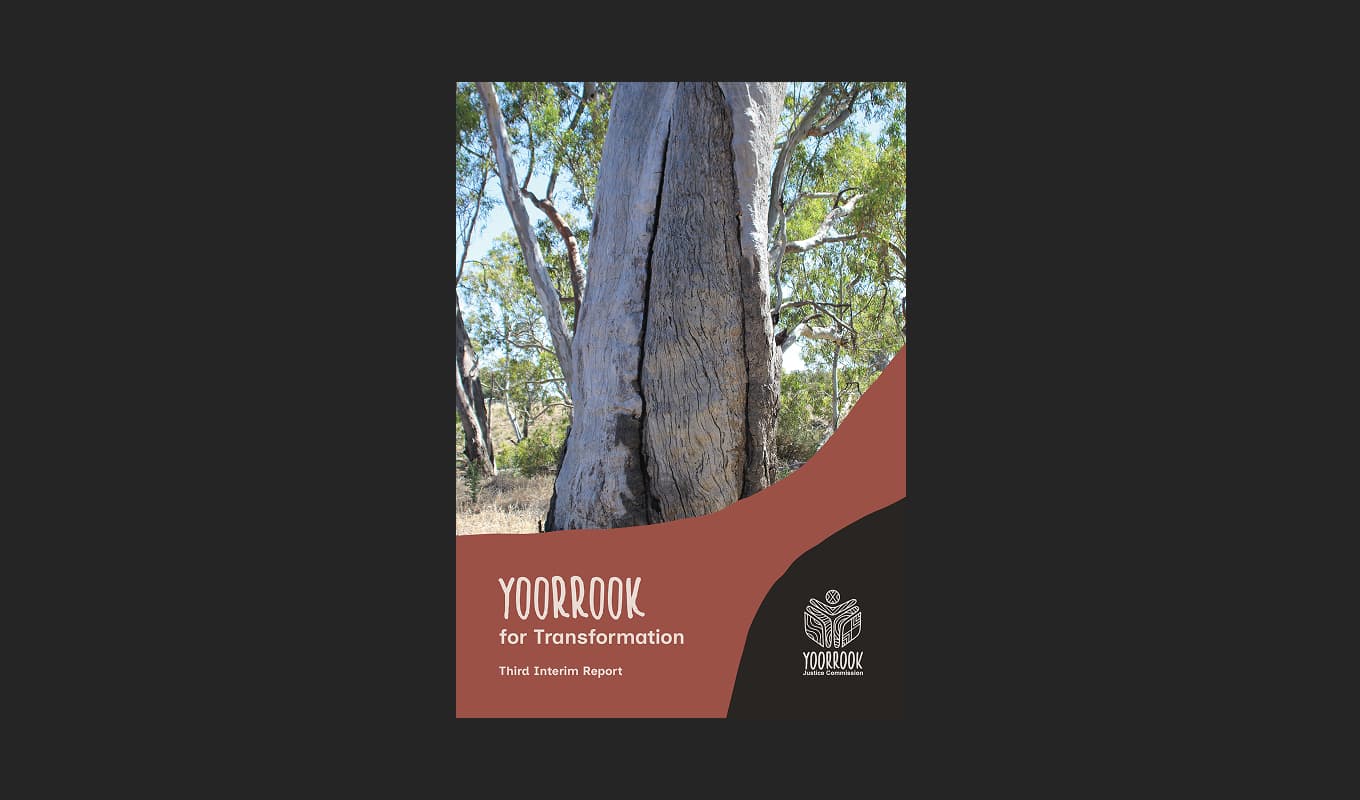
Yoorrook for Transformation
Third Interim Report: A five-volume comprehensive reform report presenting evidence and findings on systemic injustices, and specific recommendations for meaningful change to transform the future.
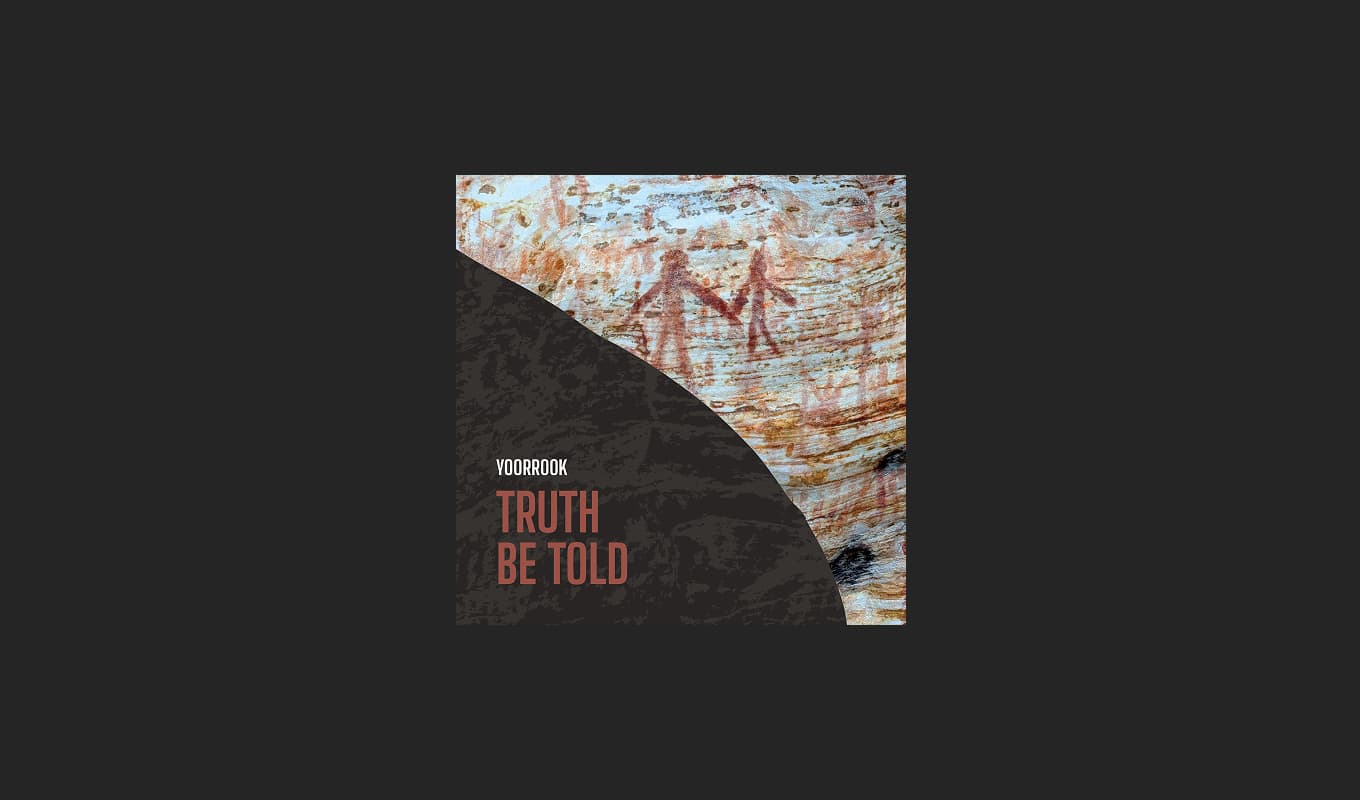
Truth Be Told
An official public record that documents First Peoples experiences since colonisation, preserves crucial testimonies for future generations and creates an enduring resource for education and understanding.
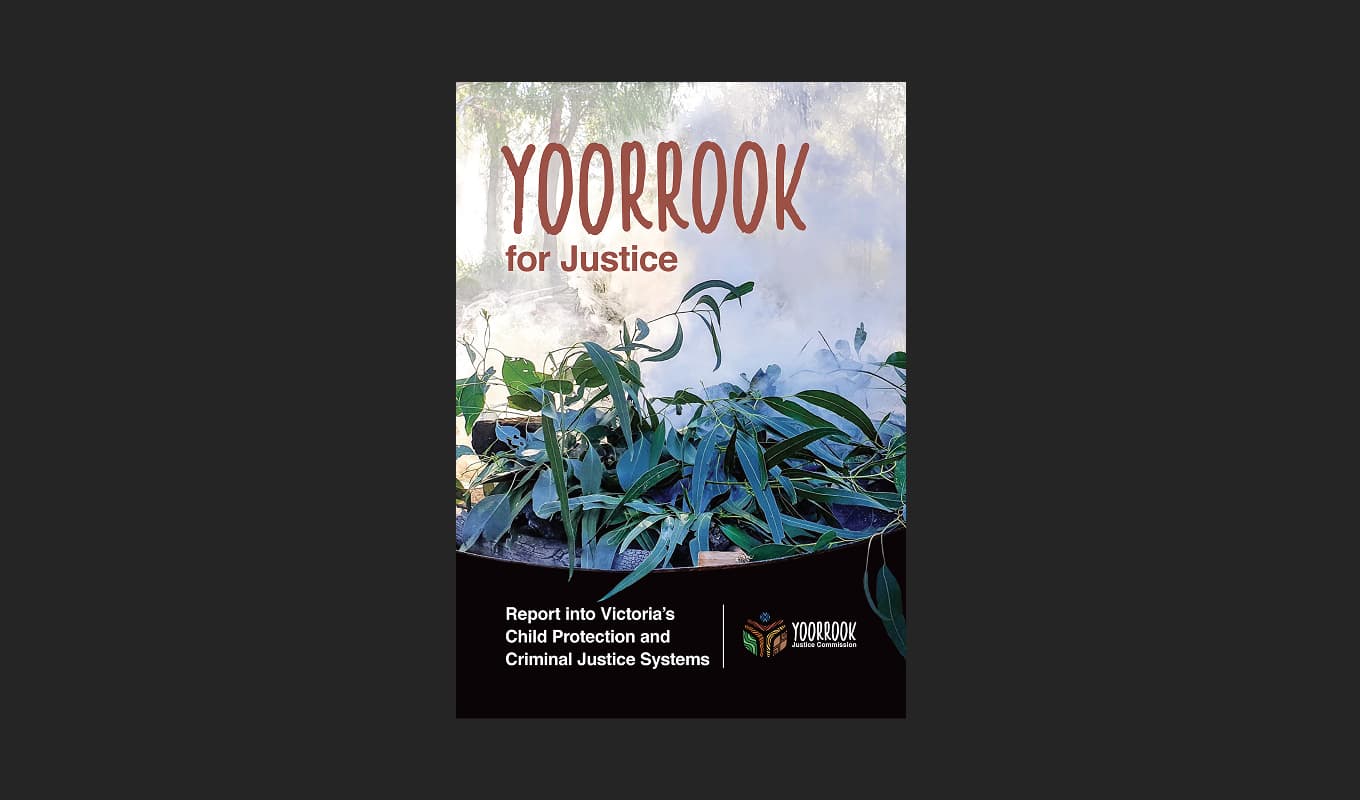
Recommendations for change
Yoorrook Justice Commission’s recommendations for truth-telling, justice, and systemic reform in Victoria.
